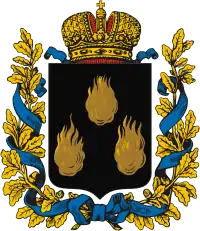Lankaran Uyezd
Lankaran Uyezd (Russian: Ленкоранский уезд, Azerbaijani: Lənkəran qəzası) was an administrative unit within the Baku Governorate of the Russian Empire, and then of the Azerbaijan Democratic Republic and the Azerbaijan SSR, with its centre in the city of Lankaran until its formal abolishment in 1929 by Soviet Authorities.[2][3] The uyezd was located on the southern part of the governorate, bordering Caspian sea to the east, Javad Uyezd to the north and Persia to the west and south.[4]
Lankaran Uyezd
Ленкоранский уезд | |
|---|---|
 Coat of arms | |
 | |
| Country | Russian Empire |
| Political status | Uyezd |
| Governorate | Baku |
| Established | 1840 |
| Abolished | 1929 |
| Area | |
| • Total | 5,400 km2 (2,100 sq mi) |
| Population (1926) | |
| • Total | 208,479[1] |
History
The uyezd was established on 10 April 1840, by the name Talyshinsky Uyezd on the basis of Talysh Khanate. It was initially made part of the Caspian oblast on 1840, and later renamed Lankaran Uyezd in 1845[3] and made part of the Shamakhi Governorate in 1846.[5] Due to an earthquake in Shamakhi in 1859, the centre of the Shamakhi Governorate was moved from Shamakhi to Baku and the governorate was renamed Baku Governorate.[6][3]
In 1918, after the collapse of the Russian Empire, Azerbaijan Democratic Republic gained brief independence. Bolshevik Baku Commune was in control of Baku at the time, and they were trying to spread their control over other places in Azerbaijan, such as Lankaran Uyezd. This led to the creation of the Mughan Soviet Republic in the territories of the Lankaran uyezd on 25 April 1919, but the republic was short-lived and it collapsed 3 months later, on 27 July 1919. Subsequently, the uyezd was integrated into Azerbaijan Democratic Republic.[7]
After the Red Army invasion of Azerbaijan in 1920, Azerbaijan was integrated into the Soviet Union and the uyezd was abolished by Soviet authorities in 1929.
Population
According to the "Code of statistical data on the population of the Transcaucasian region" from 1886, the population of the uyezd was 109,340 people, of which 50,887 (46.5%) were Tatars (modern Azerbaijanis), 50,510 (46.2%) were Talysh, 7.634 were Russians and 273 (0.2%) were Armenians.[8]
According to the 1897 Russian Empire census, 130,987 people lived inhabited the uyezd, of which 8,733 lived in the city of Lankaran. The census recorded 84,725 native speakers of Azerbaijani (whom the census indicates “Tatar”) as the native language and 34,991 Talysh.[9]
The significant share reduction of the Talysh population in comparison with the data of 1886 cannot be explained by natural demographic processes and is a consequence of the registration of Iranian-speaking Talysh as Azerbaijanis (“Caucasian Tatars”). After 1886, the Talysh did not move out and did not die out. It is clear that a significant part of the Talysh, on the basis of their language, are ranked among the Azerbaijanis (“Caucasian Tatars”).[10]
The population rose to 208,479 people in the uyezd by 1926.[1]

References
- "Population of Lankaran Uyezd". Demoskop Weekly.
- Исмаилов Э.Э. (2001). Генеология Талышинских-Талышхановых. p. 10. ISBN 5-87459-246-6.
- Чичкин А.А. (2013). Друзья и враги за Кавказским хребтом. Москва: Вече. p. 27. ISBN 978-5-4444-0737-0.
- Tsutsiev, Arthur (2014). Atlas of the Ethno-Political History of the Caucasus. Translated by Nora Seligman Favorov. New Haven: Yale University Press. p. 59. ISBN 9780300153088.
- Исмаилов Э.Э. (2001). Генеология Талышинских-Талышхановых. Баку. p. 10. ISBN 5-87459-246-6.
- "Administrative Territorial Division" (PDF). preslib.az. p. 9.
- Smele, Jonathan D. (2015). Historical Dictionary of the Russian Civil Wars, 1916-1926. Rowman & Littlefield. p. 771. ISBN 9781442252813.
- Закавказский статистический комитет. Свод статистических данных о населении Закавказскаго края, извлеченных из посемейных списков 1886 г. / Главноначальствующий гражданскою частию на Кавказе. — Тифлис: Тип. И. Мартиросиянца, 1893, 1893. — С. 337. — 487 с.
- "Первая всеобщая перепись населения Российской Империи 1897 г. Распределение населения по родному языку и уездам Российской Империи кроме губерний Европейской России" (in Russian). Демоскоп.
- Г.Ф.ЧУРСИН. ТАЛЫШИ. — Известия кавказского историко-археологического общества. ЭТНОГРАФИЧЕСКИЕ ЗАМЕТКИ.. — Тифлис, 1926. — С. 15-45.